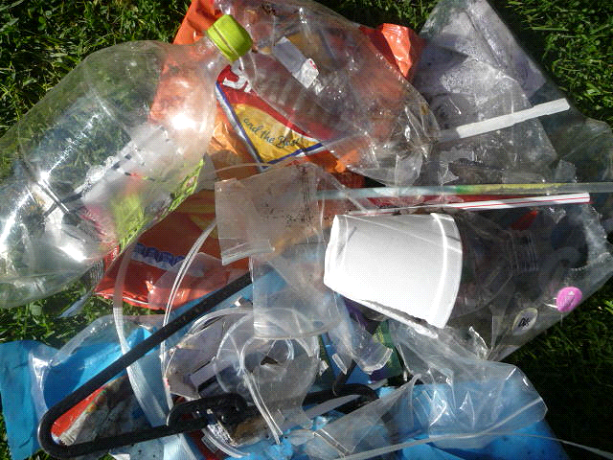Information on Oxodegradables Requested by Linked-In User
Posted on March 26, 2012 by DrRossH in Plastic Waste NewsAs posted on Linked-In Biodegradable Plastics group by PWS.
The oxo sellers have added many comments into various discussions in this group trying to convince people they have the solution. There are a plethora of issues with oxo degradables that they try to skirt with some misleading claims or simply leaving out properties of their product that would sway people away from them.
1) They can’t be main stream recycled even though some sellers say they can be recycled. When they say this they don’t tell you they are referring to can be recycled in their own oxodegradable plastic manufacturing plant mixing with other oxodegradable plastics. Outside of their plant in main stream plastics they can’t be recycled as they would contaminate other plastics that do not want to be degradable.
2) They say they program the degradation time for each application. This is nonsense and just salesmanship. How can a factory in China know how a bag or other product is going to be used for in the UK or the USA etc?
3) Claims of a solution to litter are made. Again this is nonsense and salesmanship to make them sound good. It is inconsistent with the claim they make for point 2 above. So they design a bag say to last 2 years then fragment down. What if that bag gets littered after 1 month. Are we meant to think it is ok to leave the bag sitting in the environment now for another 23 months waiting for it to fragment? That is not a solution to litter, that is promoting more unsightliness.
4) Claims of the pacific garbage patch would not be there if the plastic had oxo additives in it. Talk about dangerous. So if all the plastic in the garbage patch did fragment down to little tiny bits, plankton size, then we would have a huge number of wildlife eating and drinking plastic soup. It is bad enough now that so many birds, turtles and fish are found with plastic in their stomach, now these oxo manufacturers are telling us it is ok for this to increase many times fold.
5) Claims of biodegradation in nature are not supported that I have seen. One oft cited claim used the Arrhenius rate equation to justify baking at a high temp to simulate exposure to the environment for a long time, then to expose the plastic to a biotic environment and then take a picture to show microorganisms on the surface of the plastic bits and conclude from that therefore that the material will all biodegrade away! Another common cited report baked the plastic at a higher temp to cause it to fragment down to little pieces then mixed them with a soil sample to measure the CO2 coming off against a control. Measuring increased CO2 evolution indicated increased biological activity. While the last part of the experiment was a credible approach, having to bake the plastic at temperatures that will not be seen in nature makes the test invalid.
6) Fragmentation in a landfill has now started appearing in claims. If you go back to the additive manufacturers websites, they say they do not fragment in anaerobic landfill conditions. The fine print says that the top meter or two of a landfill has oxygen present therefore fragmentation will occur there. But this has been stretched to a blanket statement of ‘it will fragment in a landfill’.
7) What is less damaging for the environment? 1 plastic bag blowing around or 1000’s of pieces of plastic fragments blowing around? Depends if you are bag manufacturer or a person concerned for our environment and it’s wildlife we presume.

 How many people today grab a takeaway coffee cup from the local cafe to drink on the go? We don’t know, but the number must be enormous.. Most every one of the above have a plastic top that will last 100s of years. Some cafes still use plastic cups that last a similar time. Is 10 minutes of coffee worth 100s of years of trash?
These items can be seen littering our gutters and on our streets all over the place. If they were all cardboard, they would still be littered, but they would, at least, be gone in a short time.
They do not need to be made of plastic.
How many people today grab a takeaway coffee cup from the local cafe to drink on the go? We don’t know, but the number must be enormous.. Most every one of the above have a plastic top that will last 100s of years. Some cafes still use plastic cups that last a similar time. Is 10 minutes of coffee worth 100s of years of trash?
These items can be seen littering our gutters and on our streets all over the place. If they were all cardboard, they would still be littered, but they would, at least, be gone in a short time.
They do not need to be made of plastic.
 On the way home from the gym last week, a distance of about 1 km (1/2 mile), I counted the items of plastic litter on the curb as I walked. In that short distance I counted 63 pieces of plastic litter. Plastic drink bottles, bottle tops, candy wrappers, plastic film, polystyrene fragments etc. That seemed to be a lot to me. I guess it is a generational thing. Our parents would have been horrified to see that amount, whereas it seems to go unnoticed by our youth of today. In another 20 years how many pieces will there be on this stretch, -- 200? What will today’s youth think of that new amount then when they are older? Will their children be so readily accepting of a higher amount of litter?
On the way home from the gym last week, a distance of about 1 km (1/2 mile), I counted the items of plastic litter on the curb as I walked. In that short distance I counted 63 pieces of plastic litter. Plastic drink bottles, bottle tops, candy wrappers, plastic film, polystyrene fragments etc. That seemed to be a lot to me. I guess it is a generational thing. Our parents would have been horrified to see that amount, whereas it seems to go unnoticed by our youth of today. In another 20 years how many pieces will there be on this stretch, -- 200? What will today’s youth think of that new amount then when they are older? Will their children be so readily accepting of a higher amount of litter?
Masykur says:
Post Author April 7, 2012 at 2:58 amSo how did your experiment go? i know you pesotd this around april and now its been 5 months. I’m interested in using oxo-biodegradable plastics in my business and i just stumbled upon your little experiment. I would like to know the biodegradability of the product. Hope to hear from you soon! Thanks!
DrRossH says:
Post Author April 9, 2012 at 12:10 amPlease see our page on degradable options on our website. Under there you will read about landfill biodegradable plastics, compostable plastics (bioplastics) and oxo degradable plastics. I am sure you will change you mind about using oxodegradable plastics after that. Do proper research do not listen to the oxodegradable plastic additive manufacturers as there are a lot of problems with their promotions.